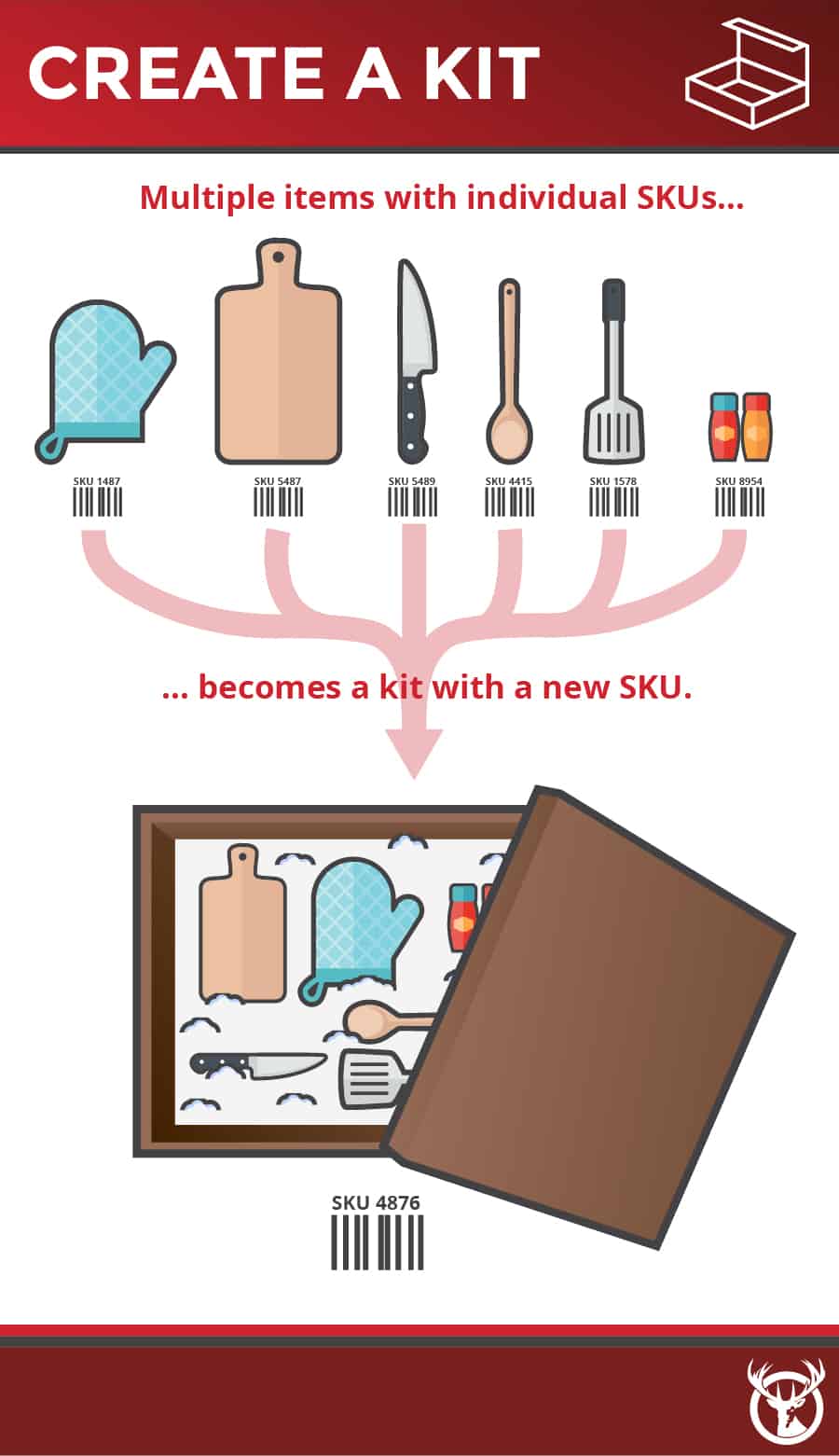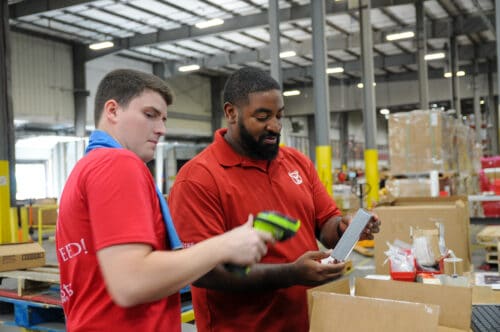Kitting is an essential element of eCommerce fulfillment. If you want the most options for efficient logistics, you want the option to add a kitting process flow to your fulfillment operations.
Traditional 3PL services include warehousing, pick and pack fulfillment, and shipping. However, fulfillment centers that offer a kitting process flow are a value-added segment of your supply chain. Kitting gives you the flexibility to do more for your customers and find new ways to increase profits and sell more products. If you haven’t added kitting to your eCommerce fulfillment strategy, it’s time to consider it.

What is kitting?
The simplest definition of kitting is putting two or more items together in the same box. With kitting, you have the option to create a new SKU that includes a bundle of products kitted together.
However, kitting is much more than simple package consolidation. The kitting process flow can include light assembly, labeling, adding marketing materials, or repackaging.

Why should eCommerce companies use kitting?
Warehouse kitting adds flexibility and resilience to your supply chain. You have more opportunities to correct a manufacturing mistake, revise your packaging, or relabel products.
Kitting services can help you create subscription boxes, gift packs, or volume product bundles that increase your sales. You can add thank you cards, coupons, or special offers to your orders.
The kitting process flow can even include light assembly and customization. Let’s look at the example of a company that sells fold-up ping pong tables. The company might find its manufacturer can fit more tables in each container and ship them more safely if the legs aren’t attached. But it wants each table delivered to its customers ready to play. With kitting services, its 3PL can connect the legs and prepare the tables for shipping.
Kitting might also help the ping pong company in another way. Perhaps it sells its tables as sets, including paddles and balls, but sources each item from a different manufacturer. The fulfillment warehouse can kit a set of paddles and a box of balls with each table.
The kitting process flow can even include customizing products. If your company sells bowling shirts to teams, for example, your 3PL can embroider names on the shirts before each order ships.

Other possible uses of kitting for eCommerce businesses
- You’ve rebranded, but you have lots of products on the shelf with the old packaging. Your warehouse can relabel or repack your items, so you don’t have to sell them at a discount.
- Delicate items such as glassware can be pre-kitted into a protective overbox so they can ship more safely.
- You want to offer your customers a subscription box option. The kitting process flow will efficiently assemble your subscription boxes.
Typical kitting process flow in fulfillment
Once you decide that kitting can help your eCommerce business, the next step is to collaborate with your fulfillment provider to develop a kitting process flow.
Identify the problem
The very first step in eCommerce kitting is to figure out what problem your kits solve. Do your customers need help choosing gift sets? Could warehouse kitting act as the final step in your manufacturing process? Do you want to offer volume discounts? What kinds of kits will work best to move your products?
Game out potential solutions
Once you’ve identified the problem that kitting can solve, talk with your fulfillment partner about the best solutions. At this point, you might want to run an A/B test with two different kits to see which sells better.
Or you might ask your 3PL to prototype a few possible kitting solutions to a packaging problem. Then send test shipments with the kitted packages to see which option is best to protect your products.
Develop an SOP for the warehouse kitters
At this point, your 3PL will design a standard operating procedure for each of your kits. The SOP acts as a manual for the warehouse kitters who assemble your kits, so they pack everything just the way you want it.

Create kits
Your fulfillment company can create as many or as few kits as you want to keep on hand. You can track the inventory of the kit SKU the way you would other inventory items.
Streamline packing and shipping
When it comes time to ship your orders, kitting can save time and reduce errors. The pickers have to make fewer stops to fill each order, and the packers can focus on packing and labeling your orders for shipping. That’s because the kitters already made sure that the kit is prepped and ready to ship.
How much does kitting cost?
Kitting is generally an extra order fulfillment service, so expect to pay a kitting fee. The charge per kit will depend on your kitting process flow, how much labor is involved, and how many items go into the kit. For instance, the charge for adding a new label won’t be the same as the cost to install legs on a ping pong table. Kitting costs might also depend on the volume of kits you need to have assembled.
Do all 3PL warehouses offer kitting processes?
Not all 3PLs do kitting in their warehouses. If kitting processes benefit your business, make sure you choose a 3PL that can do kitting.
Also, ask to inspect the kitting station. You need a fulfillment partner that employs experienced kitters, not a 3PL that will say anything to get your business.

Red Stag Fulfillment kitting process flow
Kitting is a core service at Red Stag Fulfillment. We are constantly reminded of the value of kitting to our clients. Our kitting process flow helps us help you. That’s because our experienced warehouse kitters can find solutions to any kitting problem. We have used kitting to pack delicate items for safe shipping, figure out the best packaging to reduce shipping costs, and correct a manufacturing glitch.
Not only can Red Stag Fulfillment create kits for you, but we can also unkit items. That way, if your demand forecast doesn’t match your actual sales, your best-selling items won’t get tied up in kits that aren’t moving. The ability to kit and unkit lets you keep your inventory lean and reduces the risk of backorders.
How can kitting improve your business? We’d like to help you find out.
More about kitting processes and services:









